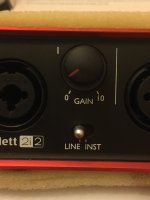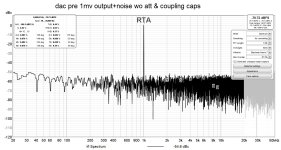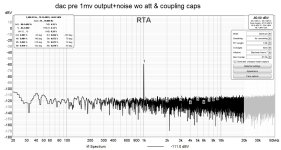It seems to me that he does all kinds of transformer.Do you know if make HV low current for tubes & LV high current for filaments?
google James transformer
I know James Transformers from Hong Kong good stuff, I guessed brand stopped making & selling transformes
Next is noise measurement at Salas’ DCG3 preamplifier output (powered by UBiB regulators), with signal at only 1 mV level.
Seeing your measurement I did a similar one for my blowtorch preamp.
I use 470uf for C2 and my version is entirely smd on alu pcbs. Glad to see that it behaves similar to the original and thanks for taking your time to do these tests.
Attachments
Last edited:
What is effect of using higher C2 value at UBiB regulator could be measured only by taking measurement at the UBiB output or preamplifier supply rail. For that, low noise instrumentation amplifier is required.
As said, UBiB output noise I’ve attached previously was done under not optimal conditions and noise floor is elevated because of that. To do the justice and show how much SOTA this regulator is, here is measurement made under better conditions: laptop on battery power, better probe and preamplifier cover closed during measurement.
Total noise in the whole audio bandwidth is about 420 nV!
Noise density from 1 kHz and up is at 2 nV/rtHz level. Mind you, those famous LT3042/LT3045 voltage regulators, that maidens sing songs about, have the same noise density and PSRR. 😀
Noise peaks at 1 kHz and all its harmonics are USB artifacts, not really something at the regulator output. We are here at the single digit nanovolt levels and even if mosquito farts nearby, that derails measurement result.

Higher C2 will have an effect on noise density below 1 kHz, which gradually rises to 5 nV/rtHz, providing slightly flatter nose floor at low frequencies.
I’m sure that blowtorch preamplifier has lower noise than in your measurement. It is limited by used sound card noise floor.
As said, UBiB output noise I’ve attached previously was done under not optimal conditions and noise floor is elevated because of that. To do the justice and show how much SOTA this regulator is, here is measurement made under better conditions: laptop on battery power, better probe and preamplifier cover closed during measurement.
Total noise in the whole audio bandwidth is about 420 nV!
Noise density from 1 kHz and up is at 2 nV/rtHz level. Mind you, those famous LT3042/LT3045 voltage regulators, that maidens sing songs about, have the same noise density and PSRR. 😀
Noise peaks at 1 kHz and all its harmonics are USB artifacts, not really something at the regulator output. We are here at the single digit nanovolt levels and even if mosquito farts nearby, that derails measurement result.
Higher C2 will have an effect on noise density below 1 kHz, which gradually rises to 5 nV/rtHz, providing slightly flatter nose floor at low frequencies.
I’m sure that blowtorch preamplifier has lower noise than in your measurement. It is limited by used sound card noise floor.
I used a focusrite 2i2 for the measurement.
To measure the noise directly at the ps you connected neg input of soundcard to - of the ps, gnd to gnd and pos input of soundcard to + of the ps?
To measure the noise directly at the ps you connected neg input of soundcard to - of the ps, gnd to gnd and pos input of soundcard to + of the ps?
Correct in principle. But, with Focusrite you can’t measure low noise levels as line-in input has noise floor density at 20 nV/rtHz at minimum gain and several uV/rtHz at max. gain. I have Focusrite Solo, but all noise measurements are performed with instrumentation LNA in front. To any measurement have meaning, level calibration must be performed using precise signal generator or by other means.
I don’t recommend to just connect 2i2 input at powered supply rail. That could overload and damage input. Solo has clamping protection at input but AFAIK 2i2 does not. Usual procedure is to connect input to rail and ground and, after all is connected, power up supply. This way there will be usual voltage ramp-up to nominal, taking several fractions of second, and that reduces peak load at 2i2 input.
Focusrite 2i2 (or Solo) can be nicely used to directly measure ripple and harmonics at standard CRC or CLC power supplies. Here is an example of such direct measurement (after level calibration) with exact ripple, rectification harmonics and PS rail harmonics produced by amplifier load ad 1 kHz.

I don’t recommend to just connect 2i2 input at powered supply rail. That could overload and damage input. Solo has clamping protection at input but AFAIK 2i2 does not. Usual procedure is to connect input to rail and ground and, after all is connected, power up supply. This way there will be usual voltage ramp-up to nominal, taking several fractions of second, and that reduces peak load at 2i2 input.
Focusrite 2i2 (or Solo) can be nicely used to directly measure ripple and harmonics at standard CRC or CLC power supplies. Here is an example of such direct measurement (after level calibration) with exact ripple, rectification harmonics and PS rail harmonics produced by amplifier load ad 1 kHz.
Its not safe connecting DC rails to signal inputs of measurement equipment without adding capacitor coupling in between. So only AC passes. Unless they are capacitor coupled and over-voltage protected already.I used a focusrite 2i2 for the measurement.
To measure the noise directly at the ps you connected neg input of soundcard to - of the ps, gnd to gnd and pos input of soundcard to + of the ps?
*If its low impedance input like 2-20kΩ the capacitors should be big 10-15uF Wima or equivalent (film caps have low distortion). Low distortion non polar signal caps like Nichicon ES (green BP) 100uF are also valid. The more the uF vs Zin the deeper of the the original 1/F noise can be seen without adding more. Unfortunately all physical things i.e. probes, cables, connectors, capacitor's windings, are magnets to common mode noise and its very difficult to avoid those intruding spikes. Unless the test loop as a whole is well screened and balanced for impedance between differential legs.
I have the inputs coupled through some bipolar(>100uf) caps followed by a 10:1 resistive attenuator. The caps aren’t the bp ones.
The measurement above was done using the above described network. The soundcard input was calibrated.
Unfortunately I don’t have a lna and that seems a must at these low levels.
What do you guys use as a lna? The one from Samuel or something else?
The measurement above was done using the above described network. The soundcard input was calibrated.
Unfortunately I don’t have a lna and that seems a must at these low levels.
What do you guys use as a lna? The one from Samuel or something else?
Did you set your preamp's and card's volume controls to unity voltage gain first? So to avoid the noise floor lift by voltage gain. Your particular audio card has more noise depth resolution to offer I think.
Attenuator at input is very reasonable solution. It minimizes risk and allows for connecting to higher voltage sources. AFAIK, all Focusrite ADC inputs are AC only with capacitor at input. In case of direct Focusrite measurements at DC levels up to 25 V, I don’t use any additional capacitor, however input attenuator would reduce risks.
There is a question of used resistor values and noise. 10 kΩ in parallel with Focusrite input produces noise floor at -105 dBV. Focusrite alone will have (at medium gain) -117 dBV noise floor.
There is no need for attenuator in case of measuring preamplifier output as it has no DC component.
EDIT: oops, slipped one zero too much in the noise calculator. 10 kΩ would produce noise at -115 dBV level.
There is a question of used resistor values and noise. 10 kΩ in parallel with Focusrite input produces noise floor at -105 dBV. Focusrite alone will have (at medium gain) -117 dBV noise floor.
There is no need for attenuator in case of measuring preamplifier output as it has no DC component.
EDIT: oops, slipped one zero too much in the noise calculator. 10 kΩ would produce noise at -115 dBV level.
Last edited:
You may also try dBc (dB carrier) in REW so the signal peak is always at zero. Along with different scaling you could achieve better visual resolution in the area of interest.
I removed the external attenuator and the coupling caps, lowered the gain of the soundcard to 0, calibrated again the input at 192k and then calibrated the input level.
The result seems similar.
The result seems similar.
Attachments
It's not the same. Noise floor is now at -120 dBV instead of -110 dBV. 👍
However, with discussion revolving around measurement techniques, we are off topic for too many posts in a row.
There is an excellent thread about all related to REW and measurements:
https://www.diyaudio.com/community/threads/how-to-distortion-measurements-with-rew.338511/
It is mostly about measuring distortion but technical issues while measuring very low distortion or low noise are similar.
However, with discussion revolving around measurement techniques, we are off topic for too many posts in a row.
There is an excellent thread about all related to REW and measurements:
https://www.diyaudio.com/community/threads/how-to-distortion-measurements-with-rew.338511/
It is mostly about measuring distortion but technical issues while measuring very low distortion or low noise are similar.
- Home
- Amplifiers
- Power Supplies
- Salas SSLV1.3 UltraBiB shunt regulator



